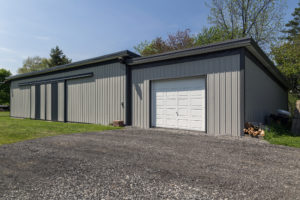
Understanding the Cost of Steel Buildings by Size: A Comprehensive Guide
Steel buildings are increasingly popular due to their durability, flexibility, and cost-effectiveness. At SteelBuildingZone.com, we specialize in connecting our clients with top steel building suppliers. In this guide, we’ll explore the costs associated with various sizes of steel buildings, considering purchasing, leasing, and renting options.
In the dynamic world of construction, steel buildings have emerged as a versatile and cost-effective solution for a wide range of applications. At SteelBuildingZone.com, we specialize in connecting individuals and businesses with top-tier steel building suppliers, offering a broad spectrum of options tailored to meet diverse needs. This comprehensive guide aims to demystify the costs associated with steel buildings, examining how factors such as size, leasing, purchasing, and renting can impact your financial planning.
Cost Breakdown by Size
1. Small Steel Buildings (Under 1,000 sq. ft.)
- Purchase Cost: Ideal for small businesses or personal use, these buildings typically range from $10,000 to $25,000. The cost includes basic design, materials, and delivery.
- Lease Cost: Leasing small steel buildings is a cost-effective option for short-term needs, generally costing between $800 to $2,000 per month, depending on the lease terms and location.
- Rent Cost: Renting is often the most flexible option, with costs averaging $500 to $1,500 per month.
2. Medium Steel Buildings (1,000 – 10,000 sq. ft.)
- Purchase Cost: These are suitable for commercial warehouses or larger workshops, with costs ranging from $25,000 to $40,000. Customizations can add to the price.
- Lease Cost: Leasing medium-sized buildings can range from $2,500 to $8,000 monthly, influenced by location and amenities.
- Rent Cost: Rental costs for this size typically fall between $2,000 and $6,000 per month.
3. Large Steel Buildings (Over 10,000 sq. ft.)
- Purchase Cost: Large steel buildings, often used for industrial purposes, can start from $40,000 and go upwards, depending on customizations and complexity.
- Lease Cost: Leasing such structures can be a significant investment, often exceeding $10,000 per month.
- Rent Cost: Renting large steel buildings typically starts from $8,000 per month.
Factors Influencing Costs
Several factors can significantly impact the cost of steel buildings, regardless of whether you choose to purchase, lease, or rent:
- Location: Costs vary significantly across different regions due to local market conditions and transportation fees.
- Customization: Specific design requirements, such as unique dimensions, insulation, doors, and windows, can add to the overall cost.
- Foundation Requirements: The type of foundation needed for your steel building, whether it’s concrete or another material, influences the total cost.
- Installation and Labor Costs: Depending on whether you opt for a DIY approach or hire professionals, installation costs can vary.
- Market Fluctuations: The price of raw materials like steel can fluctuate, impacting the cost of steel buildings.
- Building Codes and Permits: Compliance with local building codes and the cost of obtaining necessary permits can also affect your budget.
At SteelBuildingZone.com, we understand that navigating the costs associated with steel buildings can be complex. Our goal is to simplify this process by connecting you with leading suppliers who can offer competitive quotes and detailed information tailored to your specific needs. Whether you’re looking to purchase, lease, or rent a steel building, our expertise and extensive network can guide you towards making an informed and cost-effective decision.
Pros and Cons of Buying vs. Leasing vs. Renting Steel Buildings
Buying a Steel Building
Pros:
- Long-Term Investment: Buying a steel building is a long-term investment, offering ownership and the freedom to customize extensively.
- Equity Building: Owning a steel building can contribute to your asset portfolio, potentially increasing in value over time.
- Tax Advantages: Purchases often come with tax benefits, such as depreciation deductions.
Cons:
- Upfront Costs: The initial purchase cost can be significant, requiring substantial capital investment.
- Maintenance Responsibilities: Ownership comes with the responsibility of maintenance and repairs.
- Less Flexibility: Selling or relocating can be more challenging if your needs change.
Leasing a Steel Building
Pros:
- Reduced Initial Expense: Leasing requires less upfront investment compared to buying.
- Flexibility: It’s easier to upgrade or change locations when you lease, as commitments are typically shorter-term.
- Maintenance and Repairs: Often, the landlord is responsible for major maintenance and repairs, reducing your burden.
Cons:
- Ongoing Costs: Leasing involves regular payments, which can eventually surpass the cost of buying in the long term.
- Limited Customization: Options for customization are usually more restricted when leasing.
- No Equity: Unlike purchasing, leasing doesn’t build equity or investment value.
Renting a Steel Building
Pros:
- Maximum Flexibility: Renting offers the highest level of flexibility, ideal for short-term or project-based needs.
- Lower Responsibility: Maintenance and repairs are typically the landlord’s responsibility.
- Ease of Access: Renting can be a quick and easy way to access a steel building without long-term commitments.
Cons:
- Higher Monthly Costs: Rental rates can be higher than lease payments, making it less economical in the long run.
- No Long-Term Benefits: Renting does not contribute to equity building or offer long-term financial benefits.
- Limited Control: Renters have the least control over the property and face more restrictions on usage and customization.
The decision to buy, lease, or rent a steel building depends on your specific needs, financial situation, and long-term plans. Buying is ideal for those seeking a long-term investment and full control, while leasing can be a good middle ground, offering some flexibility without the high upfront costs. Renting is most suitable for short-term, flexible needs without the burden of maintenance and long-term commitments.
At SteelBuildingZone.com, we are committed to helping you navigate these options, ensuring you make the best choice for your unique requirements. Our network of trusted suppliers is ready to provide you with the information and quotes you need to make an informed decision.
Leave a Reply